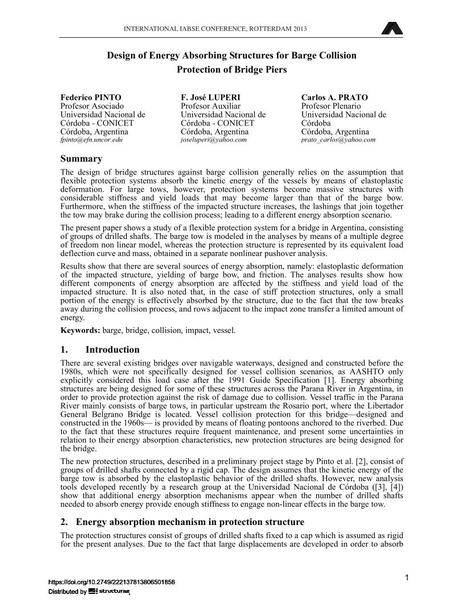Design of Energy Absorbing Structures for Barge Collision Protection of Bridge Piers

|
|
|||||||||||
Bibliographic Details
| Author(s): |
Federico Pinto
F. José Luperi Carlos A. Prato |
||||
|---|---|---|---|---|---|
| Medium: | conference paper | ||||
| Language(s): | English | ||||
| Conference: | IABSE Conference: Assessment, Upgrading and Refurbishment of Infrastructures, Rotterdam, The Netherlands, 6-8 May 2013 | ||||
| Published in: | IABSE Conference, Rotterdam, May 2013 | ||||
|
|||||
| Page(s): | 406-407 | ||||
| Total no. of pages: | 8 | ||||
| Year: | 2013 | ||||
| DOI: | 10.2749/222137813806501858 | ||||
| Abstract: |
The design of bridge structures against barge collision generally relies on the assumption that flexible protection systems absorb the kinetic energy of the vessels by means of elastoplastic deformation. For large tows, however, protection systems become massive structures with considerable stiffness and yield loads that may become larger than that of the barge bow. Furthermore, when the stiffness of the impacted structure increases, the lashings that join together the tow may brake during the collision process; leading to a different energy absorption scenario. The present paper shows a study of a flexible protection system for a bridge in Argentina, consisting of groups of drilled shafts. The barge tow is modeled in the analyses by means of a multiple degree of freedom non linear model, whereas the protection structure is represented by ist equivalent load deflection curve and mass, obtained in a separate nonlinear pushover analysis. Results show that there are several sources of energy absorption, namely: elastoplastic deformation of the impacted structure, yielding of barge bow, and friction. The analyses results show how different components of energy absorption are affected by the stiffness and yield load of the impacted structure. It is also noted that, in the case of stiff protection structures, only a small portion of the energy is effectively absorbed by the structure, due to the fact that the tow breaks away during the collision process, and rows adjacent to the impact zone transfer a limited amount of energy. |
||||
| Keywords: |
bridge collision impact vessel
|
||||
